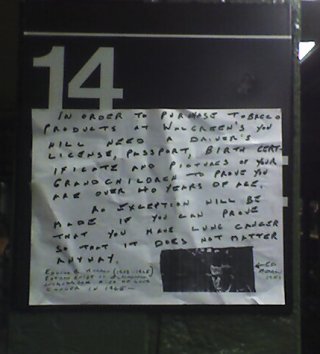Here's
another food ethics dillema for you... In order to cost-effectively raise enough pork to meet demand, pigs in the US and in the rest of the industrialized world are fed grains (corn, soy, etc.) instead of their usual omnivorous diet. The pigs are happy enough (unlike cows, which get infections and thus preventative antibiotics when fed only grain), except that their manure is very high in phosphorus. I'll explain why in just a second, but the critical environmental issue is that the manure is then used as fertilizer to grow crops (good), but the high phosphorus levels mean that much of the phosphorus runs off into nearby rivers and streams (bad). The phosphorus causes algae to thrive, reduces the oxygen in the water, and is a bad thing for fish in the water. (You may have noticed "no phosphorus" labels on laundry detergent, since until the mid-1990s, phosphorus in powdered laundry detergent was a
major pollutant.) So, it would be good to avoid having too much phosphorus in pig manure.
Now onto the explanation. The phosphorus in grains is primarily in a form called
phytate. Some animals can digest phytate, but pigs can't. Therefore, they don't get enough phosphorus in their date, and require supplements, and also their manure contains all of that undigested phytate. So feeding the pigs is more expensive than it otherwise would be, and the pigs cause pollution.
There are a couple of solutions that have been tried. Some work has been done on using breeding or genetic modification to reduce the phytate in grains, but that work hasn't been very successful, as it tends to reduce yields in the crops. Many pigs in commercial farms are fed, as a supplement, an enzyme called
phytase (enzymes end in -ase...), which comes from fungus and allows the pig to partially digest the phytate. But that's expensive too, only partially reduces the need for supplements, and only reduces the phosphorus in the manure by 40%. So what to do?
As I first saw in an
article from the New York Academy of Sciences, Canadian scientists have taken a different tack. Don't change what goes into the pig;
change the pig.

They've identified the gene in the bacteria E. coli that makes that phytase enzyme, and have inserted it into a line of genetically-modified (but otherwise very pink and cute) pigs, trademarked the Enviropig. The pigs make the enzyme in their salivary glands, which allows them to digest the phytate much better, no supplemental phosphorus or fungal phytase in the diet is needed, and the phosporus in the manure is reduced 60%, which would significantly reduce the problems from runoff.
So then the moral dillema. Here's a relatively straightforward genetic modification that allows pig farming to have significantly less of an impact on the environment, and could also reduce the costs of raising pigs, lowering food prices to the poor. These are good things. On the other hand, there are safety issues that need to be addressed. As the researchers themselves acknowledge, it's unclear if the DNA or proteins might cause problems if it jumps to another species. This gene is totally novel to pigs, and who knows how it might behave. Low levels of phytase in the meat might be toxic or allergenic. The modification could interact in all sorts of unintended ways. Is it worth the fairly complicated and lengthy testing that would be necessary to make these pigs a commercial product? Would you feel good about eating a pork chop with reduced environmental effects, even if you knew it was safe, or would the genetic modification of your bacon be a bad thing?
These are of course exactly the same issues with GMO foods like
Bt corn, which makes an organic pesticide, reducing the need for other pesticides to be sprayed, or
Roundup Ready soybeans, which allows the relatively-safe Roundup herbicide to be sprayed on fields instead of other more harmful farming practices (excessive tilling, more toxic herbicides). Both are in widespread use, despite ongoing controversy, in the US and some parts of the rest of the world. Although genetically modified plants are fairly common now, the Enviropig may be the first animal to become a controversy, and possibly a product, in the years ahead.
Labels: food, science
 I got a new camera this weekend. It's a Panasonic Lumix DMC-FZ20, a so-called "ZLR" camera with a big impressive-looking lens, but without the through-the-lens feature of a true SLR and without the ability to replace the (big impressive-looking) lens. On the other hand, it's a lot cheaper and lighter than a true SLR. It's a 5MB digital, with lots of cool features, including 12X zoom and optical stabilization to reduce blurring with hand-held shots. The above photo is the first food pic I've taken with the camera; an egg (hard-boiled). (36 mm equiv, ISO 100, 1/80 s, F 8.0, natural light.) I'm sure there will be crappy cell phone photos of food on this blog for the forseeable future, but there may be some better photos too...
I got a new camera this weekend. It's a Panasonic Lumix DMC-FZ20, a so-called "ZLR" camera with a big impressive-looking lens, but without the through-the-lens feature of a true SLR and without the ability to replace the (big impressive-looking) lens. On the other hand, it's a lot cheaper and lighter than a true SLR. It's a 5MB digital, with lots of cool features, including 12X zoom and optical stabilization to reduce blurring with hand-held shots. The above photo is the first food pic I've taken with the camera; an egg (hard-boiled). (36 mm equiv, ISO 100, 1/80 s, F 8.0, natural light.) I'm sure there will be crappy cell phone photos of food on this blog for the forseeable future, but there may be some better photos too... 













